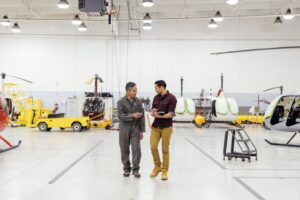
Strong distributed workforces mean stronger governments

Last year’s switch to remote work was as unexpected as it was rapid. In New York, where I was Interim Chief Information Officer (CIO) for the State of New York, it required a unified effort to secure and deploy new technology.
We expanded an existing work-from-home pilot program and used our experience to quickly deploy devices and enable secure remote access to state systems. Our technology teams rose to the occasion, and our workforce responded admirably by continuing to run the government despite a raging pandemic and a new way of working.
But the future of government work is not either “remote” or “work from home.” It is flexible and distributed. It’s clear there is—or will be—a sea change in expectations among the workforce and employers about working from home even after it is safe to return to work.¹
Work has moved to the home, but we have yet to build a mature distributed workforce.
Enabling distributed work: embrace hybrid
While a fully distributed workforce can work from anywhere, George Day, a professor at the Wharton School of the University of Pennsylvania, encourages a hybrid model. He believes that a fully remote model is not sustainable, and instead, government agencies should adopt “some kind of a hybrid model, where many people will work from a home office or in a distributed office and then come in once a week.” Variables such as security, privacy, union contracts, and legal constraints make it much more difficult to switch to a hybrid work model. But it is not impossible.
It starts with support from the top
To make a hybrid model succeed, putting the technology in place that enables and empowers public servants is only one element of success. Government leaders should create comprehensive plans with new policies, new professional development opportunities, and a fresh look at everyday practices. I know it can be done. 18F, a federal office dedicated to helping agencies with technology challenges, has been operating this way for years. Still, office-based work has decades of procedural and cultural momentum behind it. Transformative shifts require direction and support from elected officials and executives.
Create new policies
As Mark Headd, a consulting engineer with .Cloud.gov, has written process eats culture for breakfast. That is as true in the public sector as in the private. When it comes to distributed work, government agencies will need to rethink how they define and oversee remote workers. The Telework Enhancement Act of 2010 US federal government established rules for remote work in federal agencies. A legal basis greatly simplifies things and helps avoid confusion about what rules are in place and to whom they apply.
Although many of these policies are simple in principle, they are not easy to implement. Stakeholders from elected officials to unions will have a lot to say. As a result, widespread change will require lots of negotiation, consensus building, and dedicated effort.
Deploy the technology
Technology to support distributed work is no longer optional and is sometimes the easy part of the transition. Workers need laptops, Virtual Desktop Infrastructure, and bring your own device (BYOD) support. They also need the right systems in place, from cloud to two-factor authentication to support their work securely. The good news is that efforts to move employees remote, typified by Calgary’s example or my own experience in New York, have gone a long way to getting the technology in place.
In the long term, the technology is table stakes. But every moment a government delays will leave it operationally vulnerable in the meantime.
Provide new training and professional development opportunities
A changing workplace means a changing workforce. Training and professional development opportunities help ensure that the government workforce (technical and otherwise) is prepared to take on the challenges of an increasingly digital job. London Borough of Waltham Forest took a proactive approach to train its critical workforce in key digital skills. That enabled them to overcome uncertainty and succeed in the new environment.
There is not a single approach that will work for all employees and agencies. In New York, we brought together internal stakeholders to identify high-need areas. We also partnered with external companies to provide additional training as part of the NYS Tech Swat Program. This prepared employees to deliver government services remotely and developed remote-minded communication strategies for their teams.
Rethink everyday practices
A remote workforce needs to work effectively from different places and time zones, resulting in asynchronous communication and collaboration. Day-to-day work practices should be rebuilt from the ground up in the belief teams as they will not be working in the same physical space.
We must also digitize and automate office processes that have lingered in paper forms. Digitizing and automating processes don’t merely make them more efficient, it makes digital records of those processes available virtually—a key element to help managers and employees track and assess the success of new processes.
These reforms won’t come without cost. Much like the technology that enables them, developing and maintaining new processes and practices require investment. Both the European Union and the U.S. federal government have proposed spending hundreds of millions of dollars for technology modernization. They should be sure not to overlook sufficient funding to implement operational changes necessary to make the most of new technology.
COVID-19 has highlighted how important it is to have robust and flexible operational plans. A day-to-day work environment that supports distributed work is more resilient and flexible in the face of disruptions to normal operations. The same things that support distributed work daily will support an effective response to an unexpected change in work conditions. During times of maximum disruption, residents need government to work more than ever. A strong, well-supported distributed workforce will help governments remain effective and productive even under those conditions.
The future is distributed. Governments have demonstrated they can support large segments of their workforces working remotely, and now they must prepare for the next phase by building a comprehensive, thoughtful framework that supports not just a new place to work, but a new way of working.
Read about the importance of remote access within governments and visit Microsoft in Government to learn more.
¹How the Coronavirus Outbreak Has and Hasn’t—Changed the Way Americans Work, Pew Research Center, December 9, 2020.




